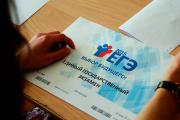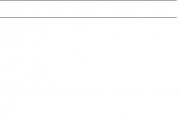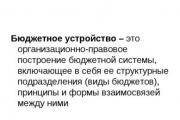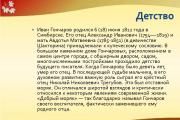What kind of correspondence happens? Rules for conducting business correspondence. Speech formulas, or cliches
With the advent of the twenty-first century and the widespread use of computers, business correspondence on paper has practically died out - it is used only where an exorbitant level of formality is needed. But this does not mean at all that the rules of business correspondence have also died out. Even in emails, they should be followed.
Rules for writing business correspondence
When you sit down to write a business letter for the first time, you will probably feel confused. After all, this is not at all the same as dropping a message to a friend or relative. How to contact your interlocutor? Should I use emoticons or not? How to fill out all these numerous fields?
You should start in order and first remember the general rules for handling email work letters.
- Examination. If business correspondence is not your main field of activity, you can check your mail twice - in the morning, when you come to work, and after lunch. If communication with clients and business partners is part of your daily activities, it will be easier to install an email client that will display notifications about letters on your desktop.
- Answer. Unspoken etiquette requires that the answer to a letter be written as quickly as possible, therefore you can ignore letters only if there is something that cannot tolerate distraction. The official rules state that a letter should be answered ten days in advance if it is received by mail, and two days in advance if it is received by fax.
- Storage. You should ensure that emails do not end up in the spam folder. In addition, they cannot be deleted: otherwise, if a conflict situation arises, it will not be possible to simply refer to the correspondence and see who is right.
- Usage. You can use a company’s email address only when corresponding on its behalf. If for some reason you need to use a personal E-mail for correspondence, you should make sure that it looks official and does not contain obscene or vulgar words.
We sorted out storage, figured out response times and which E-mail to use. All this is easy to remember and you can move on to the next step: a business letter has arrived. How to answer it without offending your interlocutor? - Correctly. Letters like “Hi Vasya, I received your letter and I thought...” should be reserved for personal correspondence. Conducting business correspondence requires correctness and politeness. You cannot use slang, expressive, or rude expressions. You cannot use emoticons, even if you have been working with your interlocutor for several years. You cannot address yourself as “you” and be familiar - the letter must be polite and dry.
- Competently. Literacy is an indicator of cultural development, intellectual level, a way to maintain the company’s reputation and write a letter stylishly. If you are not good with the Russian written language - which is often the case and is not at all a reason for shame - use special services to check grammar, spelling, and punctuation.
- Adequately. Even the most competent and correct answer can be wasted if the interlocutor simply does not understand what you are talking about. Therefore, you should either refrain from using professional terms or give them an explanation. Also, you should not use words that are too complex or not too common, which can confuse the interlocutor. And, of course, you should not insert words whose meaning you doubt.
- Logical. If you don’t know the answer, ask your interlocutor to wait, find out and write another letter. If known, check that it is presented in the letter consistently, logically and clearly, and only then send it.
- Beautiful. Design is no less important than content. You should use paragraphs, quote the question and only then give an answer, use numbered and bulleted lists.
In order to respond to an incoming letter, it is enough to do it competently, correctly, adequately and logically. But how to write a letter first?
First, you need to format it correctly:
- Subject . The “Subject” field in the body of the email should not be ignored, because it is by reading it that the interlocutor will form the first impression of what is required of him. Ideally, it should look like this: “Name of the enterprise, Essence of the problem” - “JSC Romashka”. Glass supplies."
- Signature . Most email services allow you to set up an automatic signature, which should include: “Name, position, company” - “I.V. Makarova, chief accountant of Romashka OJSC.” This form will allow the recipient to easily figure out who he is addressing and how to begin his response.
- Greetings . The greeting should not be familiar - no “Hello”, “good day”, “aloha” or other similar options. A neutral “Hello” or “Good afternoon” would be best.
- Appeal . Addresses by name - "Anya" - instead of the full name - "Anna Dmitrievna" look familiar and can spoil the entire impression of the letter. Therefore, it is better to choose an address by name and patronymic.
- Length . Letters that are too long are time-consuming and difficult to read. Therefore, the optimal volume is considered to be the one that fits into a standard page of a text editor.
General rules for working with letters, replies and new letters - learning to write all this is not difficult. But there are a few more nuances to remember:
- Content . The letter should contain the reason why it was written, a consistent description of it, and then questions and suggestions.
- Importance . Most email services have an “Important!” checkbox that you can check when writing. Then such a letter will be highlighted in the recipient's folder.
IMPORTANT! You can’t just use a checkbox - otherwise a truly urgent letter will simply drown in the abundance of thoughtlessly highlighted ones.
- End of dialogue . According to the rules of unspoken etiquette, the person who started it ends the correspondence.
- Time. Sending letters at the end of the working day and on Friday afternoon is not only bad form, but also a futile idea - anyway, the answer will only come the next morning or even on Monday.
- Politeness . We should congratulate you on the upcoming holiday. Thank you for your reply. If it is not possible to respond to an urgent letter promptly, the addressee should be notified about this.
- Attachments . Any attachment should be archived and the recipient should be notified about it separately in the body of the letter.
IMPORTANT! The rules of electronic business correspondence require attentiveness to the interlocutor - you need to let him speak, ask questions, and not demand anything in the form of an ultimatum.
Types of email correspondence
The rules governing correspondence may vary slightly depending on where the letter is sent.
- Internal correspondence implies that it is advisable to respond to letters on the same day, so as not to hinder the work of your own enterprise, and also that the tone of the letter may be somewhat more familiar than in other cases.
IMPORTANT! It would be a good idea to develop a single template for internal correspondence, according to which employees can write letters quickly, without racking their brains over the structure.
- External correspondence implies a greater degree of formality, as well as the need to filter professional slang - often an interlocutor from another company simply will not understand specific words.
- International correspondence implies greater formality, as well as the need to take time zones into account. So, you shouldn’t send a letter to New York in the morning and expect that the answer will come in the near future, worrying and rushing, because the employee who must answer the letter is most likely still basking in bed.
However, there are no big differences. Politeness, literacy and the ability to clearly formulate a request are valued everywhere.
How to write a business letter
To prepare the document, use Microsoft Word and the following rules:
- organization letterhead;
- Times New Roman font;
- wide fields;
- size 12-14 p.;
- line spacing – 1-2 p.;
- Place the page numbers of the letter at the bottom right side.
If this is international correspondence, then the letter is written in the language of the addressee.
Structure of a business letter:
- Appeal;
- Preamble;
- Main text;
- Conclusion;
- Signature;
- Application.
What else is important to remember:
- Address your interlocutor using “you”.
- If you are writing a response to a received letter, make a note about this at the very beginning, for example: “To your request, dated 01/01/2020...”
- If the letter was received with aggression, do not be like your opponent and do not use aggressive, pleading expressions or a commanding tone in your correspondence.
- Write each new thought on a new line, so the information will be better perceived. Don't make long paragraphs. Maximum 5-7 sentences.
- Avoid words written Caps Lock (in capital letters) - such text is perceived as a threat.
- Don't forget to include the sender's contact information and the date the letter was sent.
- In business correspondence, do not use emoticons or quotation marks.
- Do not use foreign words, choose a Russian synonym.
- Write in one font. Do not use colored text or excessive underlining, bolding, etc.
- Be polite to your interlocutor and open in communication. Clarify his opinion and ask what he thinks about this. Show empathy and respect.
- Watch how your opponent responds to you.
Standard phrases acceptable for use
In order not to think every time in what form to put your thoughts, you can use standard phrases accepted for business correspondence:
- Appeal. “Hello, dear Igor Petrovich”- if you know the recipient personally. "Hello, Mr. Smirnov"- if you write to him for the first time in your life. The military is usually addressed "Hello, Comrade Colonel Smirnov".
- Notice. Standard example phrase: “We inform you that...”. It can be changed to "Please be informed", “we inform you”, “we inform you”.
- Explanation. To inform the addressee about the purpose of the letter at the very beginning, you can use the following constructions: “In response to your request...”, “For the purpose of carrying out work...”, “In order to provide assistance...”, “In accordance with your wishes...”.
- Request. The request in the letter should be according to the formula "We ask you…".
- Offer. “We can offer you...”, “We recommend you...”.
- Confirmation. “We confirm...”, “We have received...”.
- Refusal. “Your proposal is rejected...”, “For the reasons described below, we cannot agree...”, “Your proposal has been reviewed and found to be unconstructive.”.
Formality is the best companion for business correspondence, but it is important that the meaning is not lost behind the official phrases. A good example of a business letter would look like this:
Hello, Igor Petrovich!
In connection with the expansion, OJSC Romashka needs to increase batches of raw materials for the production of equipment by 25%. Our cooperation with the Margaritka company has lasted for 5 years and so far we have not had any reasons for complaints. Therefore, we propose to discuss the possibilities of increasing supplies and the difficulties that may arise.
With hope for productive cooperation, General Director of OJSC Romashka, G.V. Smirnov.
******************************************************************************
Ethics of business correspondence
28.07.2015Snezhana Ivanova
If a person is going to conduct business correspondence, he needs to know several components. So what should you pay attention to?
The life of a modern person cannot do without constant interaction with other people. In our age of rapidly developing information technologies, people are increasingly turning to emails, sometimes replacing the need for personal meetings. Ethics in business correspondence involves adherence to some important rules that influence the outcome of correspondence interviews.
In fact, business correspondence is a significant element of business communication. In some cases you cannot do without it. If a person is going to conduct business correspondence, he needs to know several components. So what should you pay attention to?
Speech literacy
If during an oral conversation it is still possible to make a speech error and the interlocutor will treat this with condescension, then in a business letter the presence of such flaws is completely unacceptable. In this case, your recipient will most likely put the letter aside and not continue reading. Whoever you write to, try to do it correctly, without spelling and punctuation errors.
Literacy of speech is valued everywhere. The knowledge of such an employee will be welcomed everywhere. Sometimes diligence can replace a lack of knowledge, which, if desired, can be made up for and obtained in various ways.
Conciseness and clarity of presentation
A business letter must contain only the essence of information that is of practical value. It is completely unacceptable to indulge in long, lengthy arguments or bore your addressee with unnecessary details. All these details will not bring any benefit, but will only disappoint him and lead him to think that the information offered is unnecessary and useless.
In a business letter, information should be presented in a very structured and concise manner. Your task is to convey a specific thought or news to your interlocutor, and not lead him to deep thoughts about life.
Deadlines
When writing business correspondence, it is extremely important to comply with the deadlines for sending letters and try to respond as quickly as possible. For example, if an established client expects an immediate response from you on some important issue, then postponing and any delay can lead to undesirable consequences, such as cancellation of the contract, failure of an important deal, etc. It is also important to send emails on time because by doing so you show your opponent how important he is to you.
Formatting an email
When composing an email, it is extremely important to consider several important points. The way it is designed will determine what impression the recipient will have of you.
Fill in the “Subject” field
Surprisingly, in practice there is often a situation where important letters containing necessary and necessary information are left without indicating the appropriate subject! Such inattention or a deliberate reluctance to burden oneself with unnecessary actions actually results in missed deadlines and an increase in the likelihood that the letter will not be opened by the addressee at all.
For this reason, it is necessary to fill out the “Subject” field. This must be done even if you are not going to tell your interlocutor anything significant. There is a fairly high percentage of spammers on the Internet who deliberately clog up email and distribute malware.
Availability of personal appeal
Agree, it is much more pleasant to read letters that contain appeals to the addressee than faceless ones addressed to someone unknown. The presence of an individual appeal in a letter emphasizes its importance. In addition, by doing so you are secretly talking about respect for your absentee interlocutor. There is no need to be familiar; always address the recipient by name and patronymic.
Correct address
How many mistakes could be avoided if all Internet users were extremely careful when filling out their email addresses. Although potential clients or others with whom you interact on a daily basis often leave their email addresses written down on paper, they are later found to be extremely indiscriminate in doing so. It is for this reason that many options arise when a composed and ready letter turns out to be unsent or even goes to the wrong address. Always check the address of an important opponent, try to record it in your diary yourself, or ask them to send you a test letter.
Working with information
Before sending a finished letter to an addressee or group of addressees, it is worth working on the formatting of the information. Sometimes you have to send quite large amounts of information via email. In this case, it makes much more sense to create a data archive. Photos and other documents should be attached to the letter as a separate file. Never unnecessarily overload a letter with unnecessary information.
Thus, the ethics of business correspondence implies strict adherence to reasonable norms and rules that every confident user of a personal computer should know.
Business correspondence and office work in general are directly related to management. The attitude towards documents is a matter of management and executive discipline. By the way the letter is composed and formatted, and how they work with it, one can judge what is happening in the organization. If we talk about traditional business correspondence, it can be divided into official and personal. Personal – these are, for example, letters of recommendation, gratitude, congratulations, condolences. In addition, letters vary in content: request, invitation, request, guarantee, cover letter, advertising letter, etc. Business correspondence includes letters, telegrams, telephone messages, fax, teletype, and electronic communications. Business correspondence is divided into incoming, i.e. received by the institution from its partners, higher organizations, and outgoing, formed directly in the institution.
By type, letters are classified as circular, directive, informational, warranty, claim, reclamation, commercial, contractual, accompanying, as well as response letters, request letters, reminders, invitations, notifications, confirmations, requests.
There are certain canons for writing official letters, non-compliance with which can not only affect the prestige of the organization, but also interfere with the resolution of important issues and the conclusion of profitable contracts. Every business letter must be impeccable in all respects and have a number of mandatory attributes: even minor non-compliance with the rules can make it invalid from a legal point of view. The quality of a business text consists of four components: thought, intelligibility, literacy and correctness.
Thought - it is the content of what you have written or what you talk about in your letters. A business letter has a specific purpose and a specific focus - to encourage the addressee to take some action and receive a specific response to this letter. To do this, you need to clearly and clearly formulate the ideas you are trying to express, otherwise you will not be able to convey these ideas or information to others. If the letter touches on several issues, they should be meaningfully separated from each other and listed in order of importance.
Another criterion for a quality business letter text is intelligibility, those. accessibility of the text for understanding. Correctness – it is the tone of what is written, which is set by the chosen words, the formality or informality of the style, and should exactly correspond to the status of the addressee of your letter, just as the cut of your suit will correspond to the circle of society to which your clients belong.
The style of a business letter is businesslike, without extraneous phrases. A short, competent, logical business letter is a sign of respect for the addressee. Such an important requirement for a business letter as literacy , reflects compliance with grammar and spelling standards. Of course, business letters must be written without errors (no erasures or corrections are allowed in the text), and neatly typed.
It should be noted that the information in the document is carried not only by the text itself, but also by elements of its design, called details.
Props – this is a mandatory information element of a document, strictly assigned to a specific place on the form or sheet.
The number of details varies depending on the type and content of documents. The sample form establishes the maximum composition of details and the order of their arrangement.
Currently the details include:
- – state emblem of the Russian Federation;
- – emblem of a government body or organization;
- – image of government awards;
- – organization code according to the All-Russian Classifier of Enterprises and Organizations (OKPO);
- – document form code according to the All-Russian Classifier of Management Documentation (OKUD);
- – name of the state or municipal body;
- – name of the institution or organization;
- – name of the structural unit;
- – post office code, postal, telegraph and electronic address, teletype, telephone, fax number, bank account number;
- – name of the document type;
- - date of;
- – index;
- – link to the index and date of the incoming document;
- – place of compilation and publication;
- – stamp of restriction of access to the document;
- – addressee;
- – approval stamp;
- – resolution;
- – title to the text;
- – control mark;
- - text;
- – certificate of availability of applications;
- - signature;
- – approval stamp;
- – visas;
- - seal;
- – a note on certification of copies;
- – the performer’s surname, telephone number or email address;
- – a note on the execution of the document and sending it to the file;
- – mark on data transfer to computer media;
- – mark of admission.
As already noted, the Internet began to play a major role in business life, in which certain rules of etiquette appeared, regulated by the Internet. One of its sections concerns registration and sending emails business content. We believe that knowledge of the basic rules of this process will be extremely useful for state and municipal employees.
It should be noted that when communicating via email, you can skip the greetings and greetings and get straight to the point. However, if you want your email to be formal, it is recommended to use the following address formula: “Good afternoon, dear (dear) plus the name and patronymic of the addressee.” And only after that should you move on to the purpose of your appeal.
Despite all the informality of communication through emails, it is necessary to remember and follow one of the most important rules for composing them - adherence to the principles of literacy and logic. Just because email is a fast method of communication doesn't mean it has to be sloppy. Be sure to start your sentence with a capital letter and use periods. Names and titles must begin with capital letters. Text written in all lowercase letters without periods or other punctuation marks is difficult to read. The text, written in capital letters alone, is generally perceived when reading as a continuous scream.
You should use spaces (blank lines) or ellipses to separate one idea from another, since they tend to act like a paragraph in an email.
Many organizations have a single corporate standard for the design of emails, including the structure of the letter itself, rules for contacting the client, signature details (full name, position, work phone numbers, email address and link to the organization’s website). In addition, this standard may prohibit the use of emoticons that are not related to the business sphere.
In general, the structure of a business email can be represented as follows:
- 1) “hat” in corporate style;
- 2) greeting;
- 3) content, purpose of the appeal;
- 4) farewell;
- 5) personal signature indicating contacts;
- 6) link to the organization’s website;
- 7) logo if necessary.
When sending an email, the fields “Subject” (“Subjekt”), “To” (“To”), and “Importance of the letter” must be filled in, if necessary.
In the "To" field, enter the recipient's email address. Sometimes there is a need to send a letter with one text to several recipients, then their addresses can be entered separated by commas. Be sure to fill in the "Subject" field, otherwise your email may be deleted as spam. Here you should enter a few words describing the subject of the message.
Some email programs allow you to specify the importance of a message. This is simply necessary if the recipient receives a large number of letters every day. A message marked "Important" receives priority when checking mail. But you should not abuse this function, as over time it may lose its main quality.
The rules of the network determine the following size of an email: it must be half as long as written on paper. If you need to send important information containing a large volume, then it is better to write a short accompanying text in an email, and format the information itself as an attachment.
When preparing to send a large attachment exceeding 200–500 kilobytes, be sure to warn your respondent about this. It's better not to send large attachments in emails. There are many other ways to transfer large texts, photos or sound without email (for example, through ftp servers or via a web interface).
In traditional correspondence, you either have to keep addressed envelopes or write them down. Remembering the email addresses of all your respondents is also impossible, and it is not necessary. To do this, any email program has the “Address Book” function, in which you can store the e-mail of your recipients and other contact information. When using this function, sending an email is much easier than sending a paper letter; just select the desired name in the address book and click the “send mail” button.
When an email arrives from a respondent listed in your Address Book, you will always know who exactly you received the email from, since the recorded contact will be reflected in the “From” field.
To reply to a received letter, just click on the “Reply” button in your mail program. In this case, a form for a new message appears, in which the recipient's address is automatically entered in the "To" ("To") field, and the subject of the original letter will be given in the "Subject" field with the mark "Re:" at the beginning of the line. By this mark, your recipient will understand that you have sent him a response to a letter on a specific topic. This way, the recipient can easily recall the meaning of the correspondence.
When replying to a business letter, you should leave all the previous text unchanged, and write your answer at the top.
Having an electronic signature in messages is a rule of good form for business correspondence. It is a specially created file (signature) containing a text signature.
Always use a signature - it will help your respondent uniquely identify you. And be sure to include several possible ways to contact you. Usually these are phone numbers, email, fax, ICQ.
An electronic signature should not exceed five to six lines, and the number of characters per line should not exceed 70.
In conclusion, we should dwell on some of the features of the network when sending and receiving emails.
After sending an email, a certain percentage of doubt remains as to whether it reached the recipient. Therefore)" next time, for the sake of your own peace of mind, you already send a letter with a notification of receipt. But according to the rules of the network, such a mark is a sign of disrespect and distrust of the respondent. It is recommended that after sending your message by e-mail, call the recipient and clarify whether your letter has arrived or not Quite often, the following wording is used for confirmation: after the text of the main letter, before your electronic signature, the phrase is written: “Please confirm receipt of the letter by a reply letter or by calling the telephone numbers indicated below.”
According to the rules of the network, emails must be answered; the response time should not exceed two days. If you need a longer time to respond to an email, it is worth explaining the reasons for the delay. It is necessary to respond to letters with damaged encoding. In this case, it is better to attach an attachment with explanations so that your correspondent is sure to be able to read it. You must also respond to emails containing an attachment: you must confirm that the attachment arrived and opened normally.
The electronic dialogue session ends according to the rules of telephone etiquette: whoever started the correspondence first is the first to finish it.
A rule to keep in mind is that if you do not respond to an email within seven days, this is evidence that you are unwilling to communicate. Therefore, if you are trying to maintain a business relationship, you need to call or send a second letter to your addressee two to three days after sending an email to clarify whether the information has reached him.
Remember that in the business world you should always respond to emails, regardless of whether they are paper or electronic. Otherwise, you may be considered an irresponsible and frivolous person, which will not have the best effect on your business reputation and career.
A unique part of business correspondence is business card. The history of the use of business cards is quite deep, but by now certain generally accepted norms for their use have emerged. They are based on the understanding that your business card is what remains with a business partner or colleague after a face-to-face or correspondence meeting with you. The card should contain not only the information that you would like to leave about yourself, but also help maintain the image you strive for with your partner.
As a rule, a business card of a civil servant is a rectangular piece of white semi-thick cardboard of good quality, on which your last name, first name and patronymic, place of work, position held, and office telephone numbers should be clearly and beautifully printed. In addition, the business card may contain other information that you want to communicate about yourself: home or mobile phone numbers, email address, etc. Additional information is usually printed in smaller font in the lower right corner. A business card may also contain information about your titles, ranks or academic degrees (professor, major general, state prize laureate, people's artist, doctor of historical sciences, etc.), which are indicated under your name.
There are no clear rules regarding the size of business cards, but usually men's business cards can be slightly larger than women's, say 90 x 50 mm and 80 x 40 mm (in the UK, women's business cards, on the contrary, are larger than men's). Large business cards are gradually going out of circulation due to the spread of special albums for storing smaller business cards.
There is a general requirement for the font of business cards - it should be easy to read. The name appears in bold font, slightly larger than the rest of the text. It is not recommended to use complex gothic or decorative fonts, as well as italics, especially if your last name and first name are difficult to pronounce or the card is in a foreign language.
Typically, a business card should contain black text on a white background, printed across the card without borders or flourishes. Recently, printing and printing organizations have been offering a wide selection of color cards on plastic or even leather, however, the norms of official etiquette do not recommend deviating from black and white. It is preferable to focus on choosing excellent quality paper that can be slightly tinted. However, you should avoid the glossy surface of the card.
In Russia, as in many bilingual countries, double-sided cards are widely used - with text in another language on the reverse side. If you adhere to strict protocol standards, the ego does not seem entirely correct, since the reverse side is intended so that some notes can be made on it. Nevertheless, double-sided cards have a right to exist, the main thing is to follow the rules for compiling them in a foreign language.
Business business cards are an essential attribute of modern business communication. The first introduction to a state or municipal employee begins with the exchange of business cards. However, during the time it takes to execute a business card, certain changes may occur that require surgical intervention. So, if an employee’s work phone number has changed, you can cross out the old one and carefully enter the new number. Crossing out and writing in the name of a new position is considered bad practice; care must be taken to order a new card as quickly as possible. In the case of a change of address, when the employee does not yet know his new telephone numbers, it is better to indicate the official address of the organization, the telephone number of the secretariat or general department.
If an organization has several branches, then several addresses may be indicated on the business cards of its representatives.
Thus, business correspondence is an integral part of interpersonal relations in society, a communication process in which all people participate through their actions, spoken and written words. Knowledge of the basic etiquette rules of business correspondence will assist state and municipal employees in carrying out professional activities.
Communication via email is an integral part of the work of any modern office worker. And accountants are no exception. How to conduct correspondence in such a way that business communication is productive, emotionally comfortable and extremely ethical? I offer readers some practical advice.
TIP 1. Do not neglect personal appeal to the addressee in your letters
By doing this, you will demonstrate your attention to the person’s personality. If a letter is written to a specific recipient, then the lack of a personal address in it looks incorrect and impolite.
When you write one of your first letters to the addressee, the question often arises: what is the best way to address him - simply by his first name or by his first and patronymic? In this case, you need to look at what is written in the signature that ends the person’s letter to you. If the name is indicated there (without patronymic), for example "Svetlana Kotova", then feel free to contact me by name. And if the signature says “Svetlana Vasilievna Kotova, chief accountant of Trenzor LLC”, then you need to address the recipient accordingly. In any case, the second option is extremely correct, and therefore a win-win.
I do not recommend relying on the information in the “From” field. After all, it is often initially filled out not by the owner of the email address, but by the company’s IT specialist when setting up email.
By the way, I strongly advise you not to use the short form of the name when addressing a business partner or client (“Sash” instead of “Sasha”, “An” instead of “Anya”), no matter how democratic the writing style and no matter how old your correspondence. What sounds familiar in spoken speech looks too simple in written speech.
TIP 2. Pay special attention to the form of your greeting
You should not use the phrase "Good day!". Even if you have the good intention of matching the recipient's time zone, this phrase sounds tasteless, I would even say vulgar. It is better to use neutral options: "Hello...", "Good afternoon...". And of course, add the recipient's name to the greeting if you know it. Personally, for example, I find it much more pleasant instead of a faceless "Hello!" get personal “Hello, Tamara!”.
Remember that in this way you save the recipient’s time. After all, he will be able to immediately assess the content of the received letter and quickly decide on its priority and importance.
The subject line should be brief, but at the same time accurately reflect the subject of the correspondence. For example, “Agreement, invoice, act from Alpha LLC” instead of "Documents". As aspects of the issue under discussion change, clarify the topic. For example, “Cooperation with Perm” → “Cooperation with Perm. Date of negotiations" → "Cooperation with Perm. Draft agreement".
If during the correspondence you see that the “Subject” field is filled in randomly by your addressee or is not filled in at all, take the initiative into your own hands and try one of two scenarios.
SCENARIO 1. When replying, fill out the “Subject” field yourself. If the recipient is attentive, perhaps this will already be enough to bring your correspondence into an adequate form.
SCENARIO 2. If the recipient continues to ignore filling out the “Subject” field, write him a letter with something like the following: “Alla, I suggest that you immediately indicate the subject of the letter in the “Subject” field. I think this way we will significantly increase the effectiveness of our communication.”.
TIP 4. Pay attention to the “To” and “Cc” fields
You need to clearly understand the generally accepted purpose of these fields in a business environment:
- <если>in the “To” field only you are listed - this means that the sender of the letter is waiting for a reaction from you to his question or request;
- <если>there are several recipients in the field - the sender is waiting for a response from each or any of the recipients. In this case, when replying, save the list of recipients set by the sender using the “Reply all” function (of course, provided that you do not deliberately want to respond only to the author of the letter, hiding the essence of your response from the rest of the correspondence participants);
- <если>your name appears in the “Copy” field - the sender wants you to be aware of the question, but he does not expect an answer from you. This means that you should not enter into correspondence on this issue. If you still decide to do this, then a sign of good form would be to start the letter with one of the following phrases: “If possible, I would like to join the discussion of this issue...”, “Let me express my opinion...”.
As for the BCC field, from a business ethics perspective, it is the most controversial email tool. Sometimes it is perceived as a tool of almost secret observation and information. After all, recipients placed in BCC are not visible to other recipients. In some, usually large companies, which are particularly scrupulous in matters of ethics, it is strictly forbidden to use this field in corporate correspondence, except for mass mailings. But in most companies they use it, observing the following rules:
- sending a letter with the “Bcc” field filled in assumes that the author of the letter has notified the hidden recipients (or is going to do so) about the reason and purpose of this form of message;
- the hidden recipient does not need to enter into correspondence.
During trainings, I am often asked the question: are there any generally accepted standards regarding the time within which it is necessary to respond to a letter from a client or colleague? But you can’t give a universal answer to it.

If we talk about internal correspondence, everything here is determined by the speed and rhythm of life of the company itself. There are companies in which a delay in response of more than an hour and a half is considered bad manners. And somewhere the answer during the day is in the order of things.
As a general rule, the most acceptable response time to a letter is within 2-3 hours. This is the so-called comfortable waiting time, when the sender waits for a response and does not experience internal discomfort from the silence of his addressee.
But what if, having received and read the letter, you realize that you cannot give a full answer to it within 24 hours? Then, according to the rules of good manners, notify the sender of your receipt of the letter and the approximate time frame for responding to it. For example: “Hello, Sergey Vasilievich! I received your letter. I’ll answer in the next couple of days” or “Andrey, I received the letter. Thank you! To answer I need more information. I will try to answer no later...”.
TIP 6. Follow the basic rules for presenting information in a letter
There are not many of them:
- when reading a letter, the most comfortable volume fits “on one screen”, maximum - on an A4 page;
- The volume of sent attachments should not exceed 3 MB. Larger files may cause mail to freeze at the recipient;
- When “packaging” attachments, use the universal zip or rar encoding. Other extensions may be blocked or cut off during transmission and create problems for the recipient;
- never start a reply as a new letter (without saving the correspondence history). Otherwise, the recipient will be forced to waste time searching for the original message;
- write in a language that is as understandable to the recipient as possible. Many people wonder whether it is appropriate to use professional or internal corporate vocabulary, slang, abbreviations and anglicisms.
This must be decided separately in each specific case.
Thus, internal corporate correspondence in a company is almost always replete with slang and abbreviations: they are familiar and understandable to all participants and save time. But you need to use them carefully in correspondence with counterparties.
There was such a case in my practice. A colleague was preparing materials for a publishing house and in her last letter they wrote to her: “Masha, please send all your materials asap”. Masha decided that this was a designation of a format unknown to her, into which the text needed to be translated. She killed a lot of time, by hook or by crook, figuring out how to satisfy the publisher's request. Imagine the Machine's annoyance when, 2 days later, it learns that the mysterious “asap” is an abbreviation for the widely used English-speaking word “as soon as possible.” But Masha could send materials within half an hour from the moment she received the request!
TIP 7. End each letter with a block of signature and your contacts
Regardless of how closely you know the recipient and how long your correspondence has been going on, each of your letters should contain a block consisting of a signature and contact information. This is an integral element of the culture of business communication.
The block must contain:
- your first and last name. There is no need to use abbreviations. Instead of “T.L. Vorotyntsev" in my signature I indicate "Tamara Leonidovna Vorotyntseva" or "Tamara Vorotyntseva" so that the addressee understands how to contact me in a reply letter;
- your position. This gives the recipient the opportunity to understand the boundaries of your authority and professional competence in resolving issues;
- contact information (phone, email, company name, website). This way you will provide the recipient with the opportunity for additional operational communication if necessary.
To all that has been said, I want to add: your emails are the very clothes by which you are greeted. In other words, by observing the etiquette of business correspondence, you will make the most pleasant impression on your recipient.
Business correspondence should never be underestimated. Along with a business conversation, it can be a good help in your career. Or vice versa, ruin partnerships. Moreover, the success of a deal or the acquisition of allies may depend on one word. A business image is based on the ability to communicate competently.
A good speaker is not necessarily a good writer. Even if a businessman is able to quickly win the trust of competitors, talk to any partner if he is brilliant conducts meetings and business conversations, then the written documents may be dry and faded. Many people just sit for hours on a blank sheet of paper, not knowing where to start. Business correspondence is a set of rules and tools that you need to know in order to competently draw up any documents.
The main feature of written speech is the use and constant repetition of uniform speech means. Stamps are often found in official correspondence. They allow express the idea more accurately, exclude different interpretations of the text, making it more concise. To write a document or letter, you can only use this set of cliches. Standard phrases have been used in writing for many decades, so anyone can easily compose text. You won’t have to spend a lot of time choosing the wording, because they will all be at hand. Documents using stamp phrases are written in a matter of minutes and do not require much effort.
Business correspondence does not accept excessive emotionality in presentation. It is characterized by a neutral tone. Instead of emotional means of assessment, logical ones are used. Dialectisms or colloquial expressions may not be used in documents. Also, a taboo is imposed on interjections or words with suffixes of subjective evaluation (diminutives, for example). It is also undesirable to use modal words in formal speech. When writing a text, you need to focus on facts, and not on the emotional component. The document must follow a clear logic of presentation.
Semantic accuracy is not a simple rule, it is an important condition that ensures the practical value of a document. The logic of presentation also acts as a legal component. If you choose a word that interprets the content in two ways, the meaning can change greatly. The entire text will take on an undesirable tone.
In business correspondence, not only the construction of phrases, but also the factual component plays an important role. Every judgment, every thought expressed in a document must be supported by a sufficient number of facts. The facts themselves should not be of the same type or insignificant. When drawing up documents, it is necessary to carefully select information, check all data, and pay attention to their reliability. If all the facts correspond to these parameters, then the reader will easily understand the meaning of what is written; he will not need additional effort or information to understand.
Moreover, the point of most business documents is to persuade the reader, to convey your point of view. Competent and convincing argumentation is the main tool for achieving this goal. Verified data, a sufficient number of facts and evidence are the main components of any document: a letter, a memo or commercial offer.
Speech etiquette for business correspondence
Like social etiquette, business communication etiquette- this is a set of rules that are entrenched in society. The norm requires compliance with these rules when drawing up documents and when communicating in writing with colleagues and partners.

For many years, business correspondence was associated with personal correspondence, so first-person verbs were used in documents. Then the letters began to acquire a public character, and personal forms of correspondence ceased to correspond with this character. Therefore, over time, the verbal formulas used in business correspondence began to transform.
The objects of transformation were expressions of verbal politeness. They began to leave business speech, giving way to stable expressions. Today, there are special stable forms that allow you to express a request or refusal, reminder or notification. We'll start explaining features of business correspondence from the use of pronouns.
When writing documents, personal perception is not used, since the information conveyed is standard. The interests expressed in business correspondence are expressed not by a specific person, but by an entire organization or enterprise. All requests or petitions described in the documents are expressed in the first person plural, and not in the singular. That is, the pronoun “we” is assumed, not “I”. However, the pronoun “we” itself is not written. The social nature of the address is expressed through the use of the verb form. The ending of the verb precisely determines the type of presentation in the first person plural.
Special attention is paid to collateral forms. The use of the passive voice is preferable. For example, the phrase “You have not fulfilled your obligations, replacing heating batteries not produced” looks too harsh, as if the writer is blaming a specific person for this. The use of the passive voice - “The obligations to replace the heating batteries were not fulfilled” - allows us to indicate the very fact of failure to fulfill obligations, and does not carry an accusation. The culprits are implied, but not specifically identified.
The use of the active voice is advisable when highlighting the official who is the source of the described actions. For example, “the legal service explains...” In this case, it is preferable to use direct word order and choose the present tense as the verb form.
The use of the passive voice is related to the nature of the information presented. If it is necessary to focus on the action, and not on the performer, then passive voice forms can be used: a letter is sent, an application is received, etc. The passive voice is also appropriate in sentences where the object is obvious. For example, “the deadlines for the work have already been determined.”
Moreover, rules of business correspondence regulate the choice of verb form. The imperfect form is used to focus attention on an undesirable action that is constantly repeated. For example, “Workers constantly violate safety rules.” The perfect form can emphasize the completeness of an action, for example, “The employees began their duties.”
Although documents have a neutral tone, sometimes it is necessary to add additional accents. For this purpose, introductory words and expressions are used. Often, introductory structures help relieve tension in the tone of the story. For example, the phrase “Please send the documents located in your office” sounds too categorical. If you change the sentence, add an introductory word: “We ask you to send the documents, which, apparently, are in your office,” then the tone will become neutral, the categoricalness and tension will disappear. Consequently, the entire proposal will comply with the norms of tact and politeness.
Another example demonstrates giving a respectful tone to a document. The phrase “Your request cannot be granted” is significantly different from the phrase “Sorry, your request cannot be satisfied.” The second option is more acceptable for business correspondence etiquette. This way you can show your respect and avoid unnecessary rudeness.

Also, introductory structures make the text less dry. The sentence “Please send, if possible, your representative as an expert to determine the quality of our products” will comply with the rules of business etiquette.
The use of introductory words and structures makes the business text less dry and categorical. With their help, you can demonstrate respect for the recipient, show your friendliness and delicacy. This allows you to preserve the professional pride of the recipient.
The most common forms of the word “respected” are used in documents and other official texts. If you put a comma after the address, the sentence will be interpreted as neutral, everyday. If you put an exclamation mark, it will indicate the importance of the document, its significance.
When addressing people of the same profession, the expression “dear colleague” (or “dear colleagues” if we are talking about a group of people) is used. The phrase “dear colleagues” is more often used when writing official congratulations, as it carries an emotional connotation. Neutral addresses simply use the word “colleagues.”
Not all business letters are official documents. regulate that when writing a text of a personal nature, it is preferable to address a person by his first name and patronymic. The surname will add formality and make the address more polite and formal.
To clarify the relationship between partners or organizations, texts consisting of two parts are compiled. The first part justifies the decision, the second is the conclusion on this decision. Depending on the nature of the text, these parts may be arranged in different orders. Psychologically, it is better to move the negative decision to the end of the letter, starting with justification. If the decision is positive, then you can start the text with it, and then write a justification.
When drawing up a document with a negative decision, you should pay special attention to the justification. The most accurate and detailed justification will help make the document more correct and create a respectful tone. A sharp refusal can affect the recipient's self-esteem, which often has a bad effect on future relationships. If you place a detailed and detailed justification at the beginning of the document, then the refusal itself will not be perceived sharply negatively.
The rules of business correspondence do not allow excessive emotionality in presentation. Documents and letters should maintain narrative neutrality. This allows you to make them more objective. You cannot use rude expressions or demonstrate disrespect or tactlessness towards the recipient. You should also avoid being overly polite. Business correspondence should not contain phrases like “please be kind.” It is better to adhere to a dry and strict presentation than to overuse polite forms.
 The neutrality and public nature of business speech does not mean that the interlocutor is not interested in who sent him business correspondence. also regulates the rules for signing documents. There is an official procedure that must be observed. If the letter was signed by the director of the company, then the response to it must also include the signature of the director or his deputy. If the letter is signed by the deputy, then according to etiquette the director can respond to it.
The neutrality and public nature of business speech does not mean that the interlocutor is not interested in who sent him business correspondence. also regulates the rules for signing documents. There is an official procedure that must be observed. If the letter was signed by the director of the company, then the response to it must also include the signature of the director or his deputy. If the letter is signed by the deputy, then according to etiquette the director can respond to it.
One of the main topics covered when writing business letters is requests. Along with the request, it is necessary to provide its justification. Letters of request are written according to the same pattern as personal or collective application forms. There are several options for presenting a request in a business letter:
- using the first person singular form (Please...);
- using the first person plural form (We ask...);
- using the third person singular form (The organization requests...);
- using the third person plural form (the President and Board of Directors request).
Business correspondence etiquette suggests that letters must be answered. The nature of the response depends on the nature of the request letter.
If a letter of request has been received, the response must include the rationale and a decision as to whether the request will be granted or not. If an offer letter has been received, the response must contain a decision whether the offer will be accepted or not. Any response letter will include a link to the request letter. When drawing up a document, it is necessary to accurately and consistently state the essence and maintain the identity of the content.














